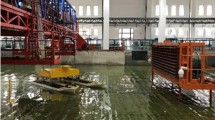Abstract
Pusher-barge systems were studied in nine different configurations. Captive model tests were performed at the Hiroshima University Towing Tank and the hydrodynamic derivatives for the various configurations were obtained. At a service speed of 7 knots, pusher-barge systems with the same number of barges but arranged in a row (shorter length overall but with a larger breadth) require more power to operate than those that were arranged in a line. When the length overall increased, the tactical diameter, advance, and transfer distances also increased, mainly due to the significant increase in the moment of inertia when barges are arranged in a line, rather than in a row. All pusher-barge systems had small first and second overshoot angles. Pusher-barge systems with the same number of barges had a longer response time to the rudder angle of attack and required a longer stopping distance when arranged in a line, mainly due to the increased moment of inertia and reduced resistance when barges are arranged in this way.
Similar content being viewed by others
References
Das PK, Varyani KS, Winkle IE, et al (2003) Assessment of load and strength of fastening systems on seagoing transportation barges. Workshop on Maritime Safety, Efficiency and Low Environmental Impact. 4–5 September 2003, Harbin, China
Grunthaner GL (1962) Commercial transportation on the inland waterways. Trans Soc Nav Archit Mar Eng 70:84–127
Eda, H (1972) Course stability, turning performance, and connection force of barge systems in coastal seaways. Trans Soc Nav Archit Mar Eng 80:299–323
Pfennigstorf J (1970) Handbuch der Werften X Band. Bearb von K Wendel. Schiffahrts-Verlag HANSA, C Schroedter, Hamburg, p 11
Yasukawa H, Hirata N, Koh KK, et al (2007) Hydrodynamic force characteristics on maneuvering of pusher-barge systems (in Japanese). J Jpn Soc Nav Archit Ocean Eng 5: 133–142
Hirano M (1980) On the calculation method of ship maneuvering motion at the initial design phase (in Japanese). J Soc Nav Archit Jpn 147:144–153
Fujii H, Tuda T (1961) Experimental research on rudder performance (2) (in Japanese). J Soc Nav Archit Jpn 110:31–42
Yoshimura Y, Nomoto K (1978) Modeling of maneuvering behavior of ships with the propeller idling, boosting and reversing (in Japanese). J Soc Nav Archit Jpn 144:57–69
Yoshimura Y, Sakurai H (1989) Mathematical model for the manoeuvring ship motion in shallow water (3rd report) (in Japanese). J Kansai Soc Nav Archit Jpn 211:115–126
Luhut TPS, Muis A, Muryadin (2005) Analysis study of train barge maneuvering in shallow water. Report of the10th Seminar and Joint Meeting of the JSPS-DGHE Core University Program on Marine Transportation Engineering. Hiroshima University, Japan, 05-2:283–294
Author information
Authors and Affiliations
Corresponding author
About this article
Cite this article
King, K.K., Yasukawa, H., Hirata, N. et al. Maneuvering simulations of pusher-barge systems. J Mar Sci Technol 13, 117–126 (2008). https://doi.org/10.1007/s00773-007-0267-4
Received:
Accepted:
Published:
Issue Date:
DOI: https://doi.org/10.1007/s00773-007-0267-4




